SNP (Single nucleotide polymorphism) and mutation are both related to the structural changes in the genome. While researching, people often use these two terms interchangeably. However, scientifically, one must be very careful while using them.
All the individuals except for the twins have their own version of genome sequences. These variations are mainly due to the SNPs. The chances of occurrence of SNP are approximated as one per thousand base pairs.
SNP indicates the condition where one individual possesses a nucleotide “A” at a specific position P in his genome. But another individual will have nucleotide “B” at that same location P.
Talking about mutations, they are actually sudden but gradually occurring changes in the natural genome. It refers to the alteration of the gene at some specific locations.
They can occur naturally or can get stimulated by certain agents called mutagens. The mutation can cause some unwanted changes in the body that might lead to some potential disorders.
This post will help you learn more about the key differences between SNP and mutations in detail.
Content: SNP Vs Mutation
Comparison Chart
| Basis of Characteristics | SNP | Mutations |
|---|---|---|
| Meaning | The SNP stands for single nucleotide polymorphism. It refers to the naturally occurring variation of a single nucleotide at a particular position in a genome. Each variation is responsible for the diversity within the population up to an appreciable degree | The transmissible alterations in the structure of the genome by substitution, addition, duplication or deletion of a specific of one or multiple nucleotides, thereby leading to the variable form of the original genome |
| Frequency of Occurrence | The frequency of the variations in SNPs is higher than 1 % within the population | They rarely occur, and the frequency of variation is lower than 1 % within the population |
| Amount of variation | Amount of variation Alteration or change in a single base unit. | It can be either a change in one or many nucleotides |
| Explanation | It is a naturally occurring historical type of change | They are novel in comparison to the SNPs and are considered the first step toward the evolution |
| Consequences | Associated with the problems like heart diseases, diabetes, blood pressure, and migraine | Causes the health issues like beta-thalassemia, sickle cell anaemia, cystic fibrosis etc. |
What is SNP?
The human genome approximately comprises 4-5 million SNPs occurring once in 1000 bp in every individual. In the human population, there are about 100 million types of SNPs have been detected so far.
SNP or single nucleotide polymorphism is the alteration of the base pair at a single position in a DNA sequence. It refers to the kind of polymorphism that implies the presence of more than one form of DNA. They are responsible for the uniqueness among the individuals in the population.
The DNA sequence consists of a chain of four nucleotide bases: A, C, G and T. These four remain arranged in a proper sequence. So, wherever there is an alteration at a single position, it indicates SNPs.
For instance, if the genetic sequence of the general population is:
A C T A G T A C G A A G G C T
Then the sequence of the individual with SNP is:
A C T A G T A C T A A G G C T
Diseases related to SNP
The SNP is associated with several complex illnesses such as cardiac disorders, cancer, blood pressure, diabetes, migraine, Alzheimer, schizophrenia etc.
Position of SNP
The SNPs lying in the non-coding region hamper the structure of mRNA, thereby increasing the disease susceptibility. Researchers use them as biological markers for locating genes linked to the disease. Also, they are useful in the STR-based DNA fingerprinting techniques.
Whereas the SNP present in the coding region can be of two types:
- Synonymous substitution: Here, the amino acid sequence doesn’t change.
- Non-synonymous substitution: This can be either missense or nonsense.
Advantages of SNP
- Nowadays, modern research techniques exploit SNPs as the latest generation of markers, mainly used in the techniques like genetic mapping and GWAS.
- Due to the change in only one nucleotide, they are abundant in number.
- We can type SNP by methods not involving gel electrophoresis.
- The SNP-based analysis is rapid as it depends on oligonucleotide hybridization analysis.
Disadvantages of SNP
- The SNPs are incapable of manifesting any variability in a family line.
- They are hard to find even with modern techniques. This is because the range of variability is very light.
What is Mutation?
A mutation is an event that produces an altered form of a gene. It gives rise to the hereditable alterations in the genotype of an organism. Whenever we see a suddenly occurring trait in a population, the reason behind it is mutation.
It is believed that mutation was the first step toward evolution. The mutation had played a crucial part in the majority of variations current population.
Definition of Mutation
A Dutch Botanist named Hugo De Vries was the one who put forward the novel concept of mutation in his studies. In 1901, he introduced the term mutation and defined it as “Sudden alteration in the structure of a gene or a chromosome.”
Another scientist named Dobzhansky, who studied mutation, defined it as “a mistake or misprint in the genetic makeup during cell division”.
What does mutation do?
The changes caused in the genome by the mutation basically change the appearance of the gene. This ultimately leads to the alteration of the characters or genetic messages under its control.
The genes are responsible for carrying the traits from one generation to another. They are exceedingly stable units that are copied exactly the same during cell division. There are chances of mistakes during this process due to mutation.
Mutation produces an altered gene called a mutant. The organism bearing the unaltered gene is termed as wild type.
Types of Mutation
We can divide the mutations into two main categories:
A. Point Mutation: This mutation occurs by replacing a single base pair with another.
Point mutations are four prominent types:
a. Base Substitution: Here, one base gets replaced by another.
b. Base Deletion: One of the bases gets deleted, causing the empty space at that spot.
c. Base Inversion: Here, there is the reversal of the base sequence.
d. Base Insertion: In this mutation, a new base pair gets inserted into the genetic sequence.
Consequences of Point Mutation
a. Silent Mutation: Here, the mRNA codon contains the changed base, which also codes for the same amino acid.
b. Missense Mutation: The changed codon codes a completely different amino acid.
c. Nonsense Mutation: Often, the altered codon becomes nonsense or a termination codon.
For instance:
UCU codes for serine.
UCU → UCA → Codes for Serine → (Silent mutation)
UCA → ACA → Codes for Threonine → (Missense mutation)
UCA → UAA → Termination codon→ (Non-sense mutation)
B. Frame-shift Mutation: It occurs when one or more base pairs shift from their original places, changing the entire framework of the genetic sequence.
Key Differences between SNP and Mutation
- The SNP is simply a change in a single base sequence at a specific position that leads to an appreciable degree of variation in the genome of a population.
In comparison, mutation refers to the induced alteration of one or more than one base pair in the genetic structure. - The SNPs occur naturally in any population, while the mutations get stimulated by physical or chemical agents called mutagens.
- The frequency of occurrence of an SNP is more than 1% throughout the population. Comparatively, the chances of mutation are rare, i.e., lower than 1% within the population.
- Only the alteration of single nucleotides takes place in the case of SNP. But the mutation can be a result of an alteration of one or more than one bases.
- The SNP is present from the historic times that were responsible for some visible changes among any population. In comparison, mutations are a comparatively novel concept. People believe mutation to be the first step toward evolution.
Conclusion
This post illustrates the major differences between SNP and Mutation with the help of a comparison chart, related information and diagrams.

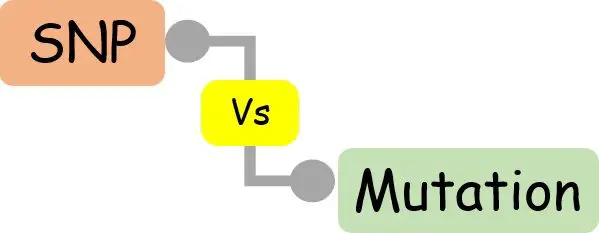
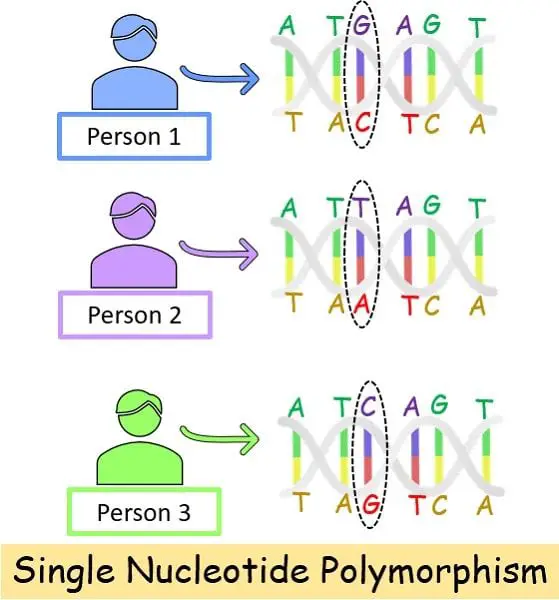

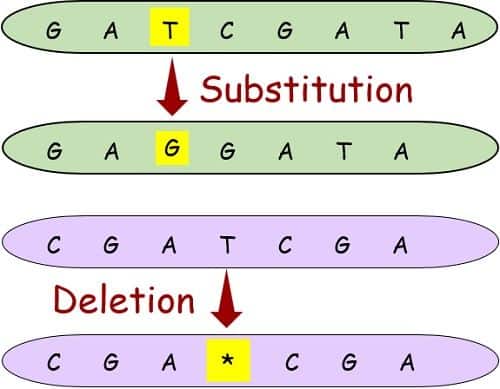
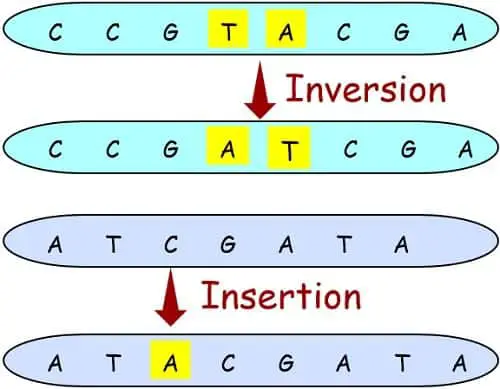
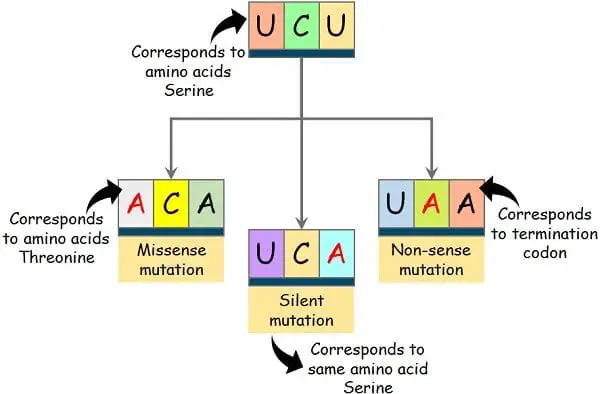
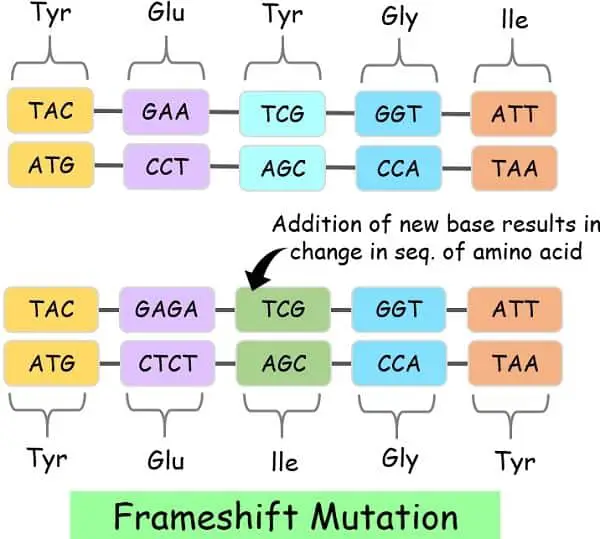
Leave a Reply